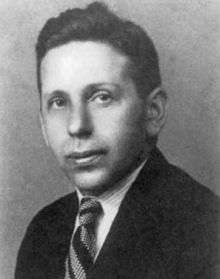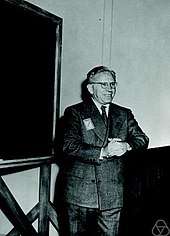Abraham Wald
Abraham Wald (/wɔːld/; Hungarian: Wald Ábrahám, Yiddish: אברהם וואַלד; 31 October 1902 – 13 December 1950) was a Hungarian mathematician who contributed to decision theory, geometry, and econometrics, and founded the field of statistical sequential analysis.[1] He spent his researching years at Columbia University.
Abraham Wald | |
|---|---|
 A young Wald | |
| Born | October 31, 1902 |
| Died | December 13, 1950 (aged 48) |
| Nationality | Hungarian |
| Alma mater | University of Cluj University of Vienna |
| Known for | Wald's equation Wald test Sequential analysis Sequential probability ratio test |
| Scientific career | |
| Fields | Mathematics Statistics Economics |
| Institutions | Columbia University Cowles Commission for Research in Economics |
| Doctoral advisor | Karl Menger |
| Doctoral students | Herman Chernoff Milton Sobel Charles Stein |
| Influences | Oskar Morgenstern John von Neumann Harold Hotelling Milton Friedman Jerzy Neyman |
| Influenced | Aryeh Dvoretzky Jacob Wolfowitz John Denis Sargan, Alok Bhargava |
Life and career

Wald was born on 31 October 1902 in Cluj, in Transylvania in the Kingdom of Hungary . A religious Jew, he did not attend school on Saturdays, as was required at the time by the Hungarian school system, and was thus home-schooled by his parents until college.[1] His parents were quite knowledgeable and competent as teachers.[2]
In 1928, he graduated in mathematics from the King Ferdinand I University.[3] In 1927, he entered graduate school at the University of Vienna, from which he graduated in 1931 with a Ph.D. in mathematics. His advisor there was Karl Menger.[1]
Despite Wald's brilliance, he could not obtain a university position, because of Austrian discrimination against Jews. However, Oskar Morgenstern created a position for Wald in economics. When Nazi Germany annexed Austria in 1938, the discrimination against Jews intensified. In particular, Wald and his family were persecuted as Jews. Wald was able to emigrate to the United States, at the invitation of the Cowles Commission for Research in Economics, to work on econometrics research.[1]
During World War II, Wald was a member of the Statistical Research Group (SRG) at Columbia University, where he applied his statistical skills to various wartime problems.[4] These included methods of sequential analysis and sampling inspection.[5] One of the problems that the SRG worked on was to examine the distribution of damage to aircraft returning after flying missions so as to provide advice on how to minimize bomber losses to enemy fire. Wald derived a useful means of estimating the damage distribution for all aircraft that flew from the data on the damage distribution of all aircraft that returned.[6][7] His work is considered seminal in the then-fledgling discipline of operational research.
Wald and his wife died when the Air India plane in which they were travelling crashed in the Nilgiri Mountains, in southern India, while on an extensive lecture tour at the invitation of the Indian government.[1] He had visited the Indian Statistical Institute at Calcutta and was to attend the Indian Science Congress at Bangalore in January. Their two children were back at home in the United States.[8]
Following his death, Wald was criticized by Sir Ronald A. Fisher FRS. Fisher attacked Wald for being a mathematician without scientific experience who had written an incompetent book on statistics. Fisher particularly criticized Wald's work on the design of experiments, alleging ignorance of the basic ideas of the subject, as set out by Fisher and Frank Yates.[9] Wald's work was defended by Jerzy Neyman in the following year. Neyman explained Wald's work, particularly with respect to the design of experiments.[10] Lucien Le Cam credits him in his own book, Asymptotic Methods in Statistical Decision Theory: "The ideas and techniques used reflect first and foremost the influence of Abraham Wald's writings".[11]
Abraham Wald was the father of noted American physicist Robert Wald.
Notable publications
For a complete list, see "The Publications of Abraham Wald". Annals of Mathematical Statistics. 23 (1): 29–33. 1952. doi:10.1214/aoms/1177729483.
- Wald, Abraham (1939). "A New Formula for the Index of Cost of Living". Econometrica. Econometrica, Vol. 7, No. 4. 7 (4): 319–331. doi:10.2307/1906982. JSTOR 1906982.
- Wald, Abraham (1939). "Contributions to the Theory of Statistical Estimation and Testing Hypotheses" (PDF). Annals of Mathematical Statistics. 10 (4): 299–326. doi:10.1214/aoms/1177732144.
- Wald, Abraham (1940). "The Fitting of Straight Lines if Both Variables Are Subject to Error". Annals of Mathematical Statistics. 11 (3): 284–300. doi:10.1214/aoms/1177731868.
- Wald, Abraham (June 1945). "Sequential Tests of Statistical Hypotheses". The Annals of Mathematical Statistics. 16 (2): 117–186. doi:10.1214/aoms/1177731118.
- Wald, Abraham (1947). Sequential Analysis. New York: John Wiley and Sons. ISBN 0-471-91806-7.
See Dover reprint: ISBN 0-486-43912-7
- Wald, Abraham (1950). Statistical Decision Functions. John Wiley and Sons, New York; Chapman and Hall, London. p. ix+179.[12]
See also
- Sequential probability ratio test (SPRT)
- Wald distribution
- Wald–Wolfowitz runs test
- Wald's equation
References
- Morgenstern, Oskar (1951). "Abraham Wald, 1902–1950". Econometrica. Econometrica, Vol. 19, No. 4. 19 (4): 361–367. doi:10.2307/1907462. JSTOR 1907462.
- O'Connor, John J.; Robertson, Edmund F., "Abraham Wald", MacTutor History of Mathematics archive, University of St Andrews.
- Anuarul Universității Regele Ferdinand I pe anul școlar 1927/28. p. 187. Online access, University Library in Cluj, Romania.
- Wallis, W. Allen. "The Statistical Research Group, 1942-1945." Journal of the American Statistical Association 75, no. 370 (1980): 320-30. doi:10.2307/2287451.
- Wallis, W. Allen (1980). "The Statistical Research Group, 1942–1945". Journal of the American Statistical Association. 75 (370): 320–330. doi:10.1080/01621459.1980.10477469.
- Mangel, Marc; Samaniego, Francisco (June 1984). "Abraham Wald's work on aircraft survivability". Journal of the American Statistical Association. 79 (386): 259–267. doi:10.2307/2288257. JSTOR 2288257. Reprint on author's web site
- Wald, Abraham. (1943). A Method of Estimating Plane Vulnerability Based on Damage of Survivors. Statistical Research Group, Columbia University. CRC 432 — reprint from July 1980 Archived 2015-12-10 at the Wayback Machine. Center for Naval Analyses.
- "Prof. Wald Reported Among Victims of India Plane Crash". Columbia Daily Spectator. XCV (52). 15 December 1950. p. 1. Retrieved 2018-02-08.
- Fisher, Ronald (1955). "Statistical methods and scientific induction". Journal of the Royal Statistical Society, Series B. 17 (1): 69–78. JSTOR 2983785. (criticism of statistical theories of Jerzy Neyman and Abraham Wald)
- Neyman, Jerzy (1956). "Note on an Article by Sir Ronald Fisher". Journal of the Royal Statistical Society, Series B. 18 (2): 288–294. JSTOR 2983716. (reply to Fisher 1955)
- Le Cam, Lucien (1986). Asymptotic Methods in Statistical Decision Theory. pp. xiii. (Le Cam 1986)
- Robbins, Herbert (1951). "Review: A. Wald, Statistical decision functions". Bull. Amer. Math. Soc. 57 (5): 383–384. doi:10.1090/S0002-9904-1951-09520-8.
Further reading
- Wolfowitz, Jacob (1952). "Abraham Wald, 1902–1950". Annals of Mathematical Statistics. 23 (1): 1–13. doi:10.1214/aoms/1177729480.